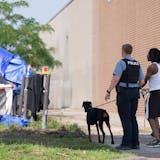On a recent Sunday, Sita Dandiker was driving quite fast when, in an instant, she went off the road and onto the gravel shoulder. Seconds later, back on the road, the teenager's vehicle hydroplaned and spun on a water-slickened road, then screeched to a halt after dodging obstacles and skidding across dry pavement.
Any one of those situations could have ended in disaster for someone who has been behind the wheel for only two months, but they didn't.
That's because the Blake High School student had a trained professional from the Glacial Lakes Chapter of Audi Club North America in the seat next to her at the time.
She was one of 30 teenagers who gave up a summer vacation day to take the eight-hour hands-on course the club put on at Dakota County Technical College in Rosemount. The class covered techniques such as safe braking, avoiding accidents, driving on slippery roads and reacting to over-steering or under-steering. All give young drivers practical experience on how to avoid crashes, control their vehicles and recover from other dangerous situations.
"I feel more comfortable and know what to do in a safety situation," Dandiker said. "This was important. These are things I will keep in my back pocket in case I lose it."
Sadly, many teens — and even adults — don't know or don't practice those skills. Every day, an average of seven teenagers die in crashes in which someone between 16 and 19 was behind the wheel. According to the Centers for Disease Control and Prevention, motor vehicle crashes are the leading cause of death for teens. Last year in Minnesota, there were 34 deaths and 11,770 injuries in crashes in which a teen was driving, according to the Department of Public Safety.
Participants paid $149 for the course. Because drivers 16 to 19 are more likely to underestimate dangerous situations and not recognize hazardous situations, Debora Lanners, of Minnetonka, said it is money well spent. She enrolled her 15-year-old son, Bennett, "before bad habits are ingrained."
Participants run a slalom course, navigate corners and are forced to make split-second decisions on whether to go left or right while traveling at speeds of 20 to 40 miles per hour. Instructors like Bill Caesar stress everything from the importance of adjusting mirrors to how a jerky pull of the wheel — instead of a smooth turn — will cause a vehicle to turn too quickly and increase the chances of losing control or even rolling.



